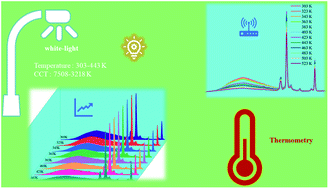Preparation of zero-thermal-quenching tunable emission bismuth-containing phosphors through the topochemical design of ligand configuration†
Abstract
Bismuth-doped luminescent materials have obtained widespread attention for solid state lighting and optical sensing due to their excellent luminescence properties and preparation in a non-reducing green environment. However, the luminescence tuning of Bi3+ is a huge challenge, restricting its application. In this work, we regulate the emission of Bi3+ through the topochemical design of the ligand configuration and means of excitation-driven. When the ratio of Nb5+/Ta5+ in the host is changed, the dissymmetry in the lattice configuration of the two cations (Nb5+/Ta5+) makes the crystal electron cloud expand, and the nephelauxetic effect increases the bond length between the activator (Bi3+) and ligand (O2−) in the host, thereby reducing the field splitting energy of Bi3+, and the blue shift of Bi3+ emission is realized. When Bi3+ replaces Y3+, Bi3+ and O2− form an irregular twisted octahedron, and each Bi3+ with a different lattice configuration is a luminescent site. The emission peak of Bi3+ can be red-shifted from 419 nm to 473 nm and is excitation-driven. On the basis of the tunable luminescence characteristics of the phosphor, a white-emitting single-phase phosphor (YNb0.2Ta0.8O4:Bi3+,Eu3+) with adjustable corrected color temperature (CCT) was prepared by building Bi3+-Eu3+energy transfer. Even more surprising is that Eu3+ appears at zero thermal-quenching, and the emission intensity increases with increasing temperature. The emission intensity of Bi3+ can reach 62.3% at 423 K, and the phosphor can still emit warm-white light at a high temperature of 443 K. Furthermore, on the basis of the unique zero thermal quenching characteristics of Eu3+, a non-contact optical temperature sensing phosphor (YNb0.8Ta0.2O4:Bi3+,Eu3+) was prepared. The material shows good temperature measurement performance in the temperature range of 303–523 K, and the relative sensitivity Sr reaches 1.80% K−1. This topochemical design of ligand configuration provides a new perspective for the development of high-performance phosphors with tunable emission.



 Please wait while we load your content...
Please wait while we load your content...